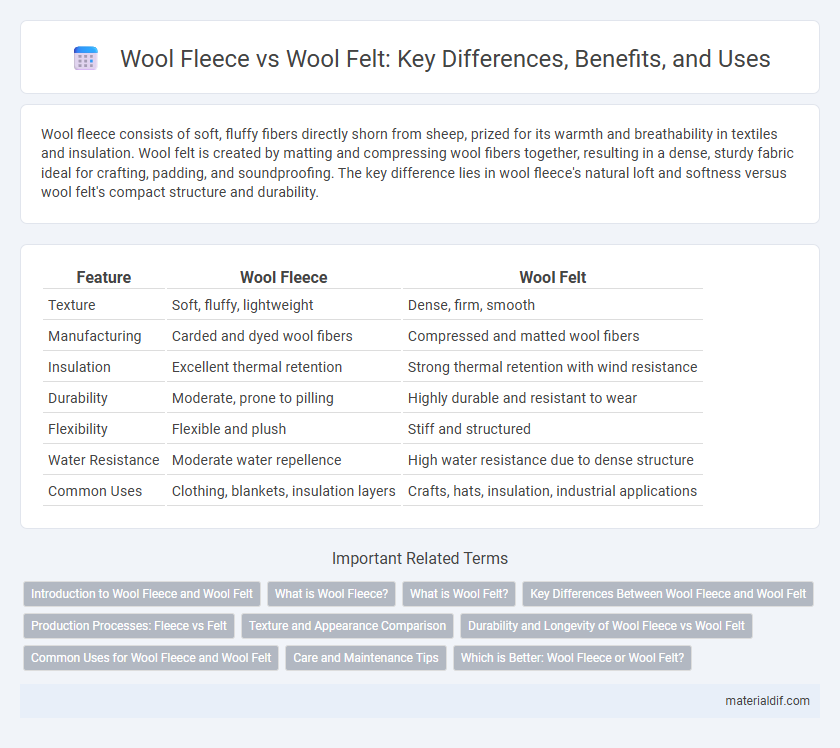Wool fleece consists of soft, fluffy fibers directly shorn from sheep, prized for its warmth and breathability in textiles and insulation. Wool felt is created by matting and compressing wool fibers together, resulting in a dense, sturdy fabric ideal for crafting, padding, and soundproofing. The key difference lies in wool fleece's natural loft and softness versus wool felt's compact structure and durability.
Table of Comparison
| Feature | Wool Fleece | Wool Felt |
|---|---|---|
| Texture | Soft, fluffy, lightweight | Dense, firm, smooth |
| Manufacturing | Carded and dyed wool fibers | Compressed and matted wool fibers |
| Insulation | Excellent thermal retention | Strong thermal retention with wind resistance |
| Durability | Moderate, prone to pilling | Highly durable and resistant to wear |
| Flexibility | Flexible and plush | Stiff and structured |
| Water Resistance | Moderate water repellence | High water resistance due to dense structure |
| Common Uses | Clothing, blankets, insulation layers | Crafts, hats, insulation, industrial applications |
Introduction to Wool Fleece and Wool Felt
Wool fleece refers to the natural, unprocessed wool shorn from sheep, retaining its softness, loft, and insulating properties ideal for spinning and knitting. Wool felt is a dense, non-woven fabric made by matting and compressing wool fibers, creating a durable and versatile material often used in crafts, insulation, and upholstery. Both wool fleece and wool felt showcase the fiber's unique warmth and moisture-wicking abilities, but differ significantly in texture, manufacturing methods, and end-use applications.
What is Wool Fleece?
Wool fleece refers to the raw, unprocessed wool directly sheared from sheep, characterized by its natural crimp, softness, and insulating properties. It retains lanolin, a waxy substance that provides water resistance and enhances durability, making it ideal for spinning, felting, and textile production. Unlike wool felt, which is densely matted through heat, moisture, and agitation, wool fleece maintains its airy structure, offering better breathability and loft for warmth.
What is Wool Felt?
Wool felt is a dense, non-woven textile made by matting, condensing, and pressing wool fibers together, resulting in a solid and durable fabric without weaving or knitting. Unlike wool fleece, which is the raw, soft, and fluffy coat of the sheep, wool felt has undergone a felting process that enhances its strength, thickness, and insulation properties. This makes wool felt ideal for applications requiring sturdy, moisture-resistant materials, such as crafts, insulation, and industrial uses.
Key Differences Between Wool Fleece and Wool Felt
Wool fleece is a soft, fluffy fiber obtained directly from sheep shearing, prized for its insulating properties and lightweight warmth. Wool felt, on the other hand, is a dense, non-woven fabric produced by matting, condensing, and pressing wool fibers together, offering durability and structural rigidity. The key differences lie in texture, processing methods, and typical applications--fleece is favored for garments and insulation, while felt serves in crafting, padding, and industrial uses.
Production Processes: Fleece vs Felt
Wool fleece is produced by shearing live sheep and then cleaning and carding the fibers to prepare them for spinning, preserving the natural crimp and loft of the wool. Wool felt, in contrast, involves matting, condensing, and pressing wool fibers together using heat, moisture, and agitation, causing the scales on the wool fibers to interlock without spinning. The key distinction lies in fleece maintaining fiber alignment for yarn production, while felt relies on fiber entanglement to create a dense, non-woven fabric.
Texture and Appearance Comparison
Wool fleece features a soft, fluffy texture with visible, loose fibers that create a naturally airy and resilient appearance, ideal for warmth and insulation. In contrast, wool felt has a dense, compact texture formed by matting and compressing fibers, producing a smooth, firm surface with a matte finish. This difference in structure results in fleece having a voluminous, textured look, whereas felt appears flat and solid with less flexibility.
Durability and Longevity of Wool Fleece vs Wool Felt
Wool fleece offers superior durability due to its natural crimp and resilience, making it ideal for long-lasting, flexible garments. In contrast, wool felt's dense, matted structure provides robust wear resistance but may become brittle over time with heavy use. Both materials maintain longevity, but fleece typically outperforms felt in maintaining softness and structural integrity through repeated wear.
Common Uses for Wool Fleece and Wool Felt
Wool fleece is commonly used in apparel and outdoor gear due to its softness, insulation, and moisture-wicking properties, making it ideal for sweaters, blankets, and thermal clothing. Wool felt, known for its dense and sturdy texture, is frequently employed in crafting, industrial applications, and home decor, such as hats, padding, and soundproofing materials. Both wool fleece and wool felt serve distinct purposes, with fleece favored for comfort and flexibility and felt valued for durability and structural support.
Care and Maintenance Tips
Wool fleece requires gentle washing with cold water and mild detergent to maintain its softness and prevent shrinking, and it should be air-dried flat away from direct heat sources. Wool felt demands even more delicate care, often needing hand washing or dry cleaning to preserve its dense, non-woven structure and avoid distortion. Regular brushing and storing away from moisture and pests help both wool fleece and wool felt retain their natural qualities and extend their lifespan.
Which is Better: Wool Fleece or Wool Felt?
Wool fleece offers superior softness, breathability, and moisture-wicking properties, making it ideal for garments and insulation that require flexibility and comfort. Wool felt, created by matting wool fibers together, provides dense durability and excellent structural integrity, favored in crafting and upholstery where firmness and resilience are essential. Choosing between wool fleece and wool felt depends on the intended use, prioritizing comfort and insulation for fleece versus strength and shape retention for felt.
Wool fleece vs Wool felt Infographic

 materialdif.com
materialdif.com